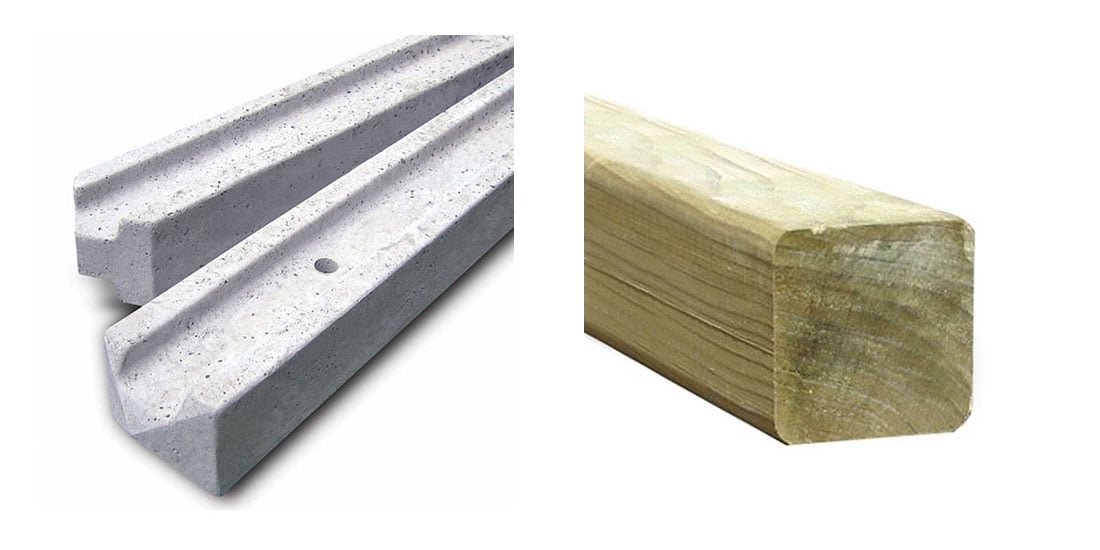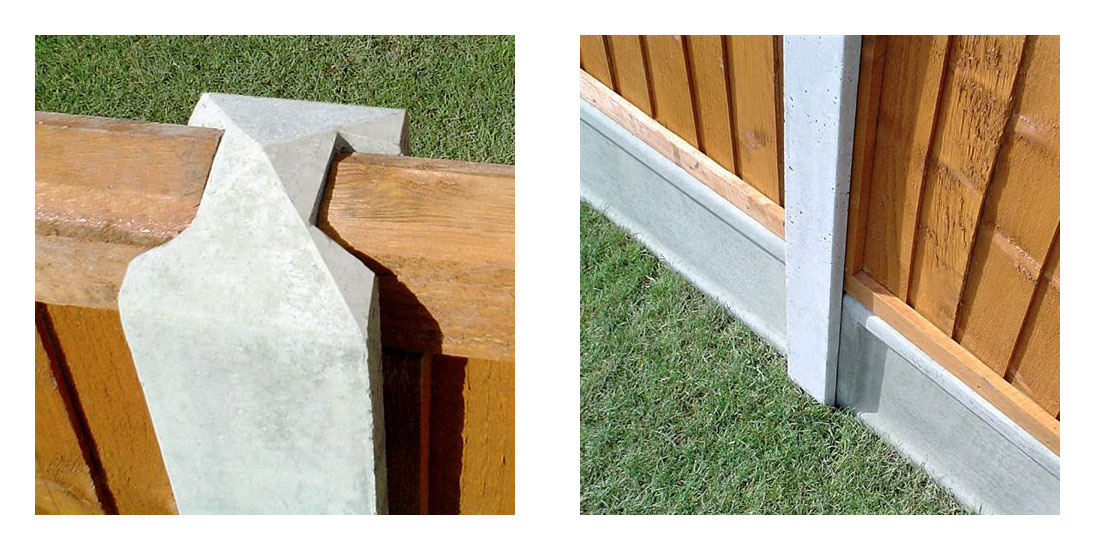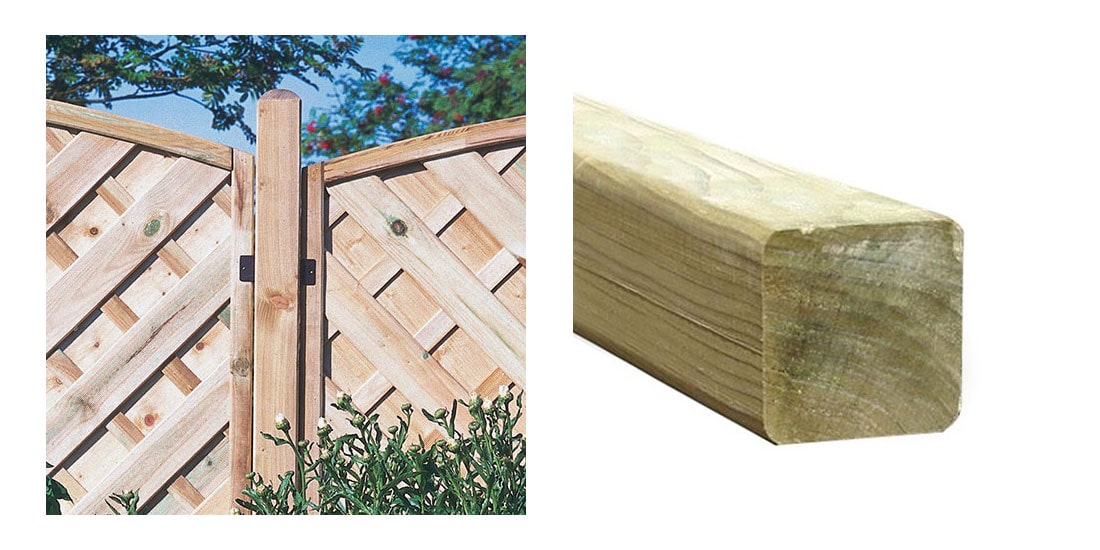
Choosing which fence post materials to use is an important but challenging decision. When comparing concrete vs wooden posts, it is crucial to consider a range of factors such as durability, maintenance, and aesthetics. Concrete and wooden posts each offer unique pros and cons, deciding between them is a common dilemma for homeowners. Here we explore concrete vs wooden fence posts and provide useful insights, which will help you make an informed decision.
Editor’s Note [23.07.2024]:
Our article comparing concrete vs wooden fence posts was originally published on December 7, 2017. The initial version had five essential comparison factors to consider, today we have upgraded to nine. New comparison factors of lifetime cost, the environmental impact, the ease of installation, as well as repair and replacement have all been added. As well as this we have also added numerous upgrades throughout the remainder of this post.
Concrete vs Wooden Fence Posts? It's a Dilemma
Imagine being an outcast on a desert island. All you can take are eight songs, a book, and a luxury.
Now the songs’ part is easy, the book simple, but the luxury. Hmmm, obviously (obviously!) it’s between a concrete or a wood fence post. Now there’s a dilemma.
To make deciding a little easier, below we list nine essential criteria to consider for your fenced garden. From the lifetime cost to relative weight, durability, as well as upkeep & maintenance, we provide the lowdown so you can reach the right decision.
1) Lifetime Cost
Concrete Fence Posts
When viewing our garden fence posts page, it is easy to see that the initial investment cost of concrete fence posts is much higher. It is difficult to provide a like-by-like example (as the two post types) are fundamentally different. On average, it can be expected that the cost of concrete fence posts compared to wooden fence posts will be somewhere between 30%-50% higher.
This extra upfront cost is justifiable by the increased durability, lifespan, pest resistance, and other factors for comparing concrete vs wooden posts we go on to discuss below.
Wooden Fence Posts
Conversely, wooden fence posts are more affordable upfront than concrete posts. This makes them more enticing to many buyers, especially coupled with the lower installation costs and effort. The lower initial cost does need to be balanced up though with the extra lifetime cost, which is discussed below.
2) Weight
Concrete Posts
Concrete will weigh in heavier. A six-foot fence panel requires a heavy frame of concrete and they do need a couple of people to handle, manoeuvre and get in place.
And once in place, there is absolutely no tweaking or phrases like ‘Don’t worry, the screws will bring it all together.’ Once in place, that is the place. Forever.
Wooden Posts
A wooden fence post, however, is slightly lighter, still heavy mind you, and - as with all posts and fencing - a helper is still a great idea.
There is a bit of tweak room with wood as it is a natural material and will be slightly more forgiving of a millimetre tolerance or two.


3) Durability and weather resistance
Concrete
Concrete posts are a long lasting solution, after all, they are virtually indestructible. How about a lifetime in length? They are also largely impervious to weather conditions, so are ideal for exposed areas. Concrete posts withstand winds, no matter how severe these might be.
Wooden
Untreated or dip treated wooden fencing where the dip treatment has expired are prone to crack, shrink, or warp. Provided dip treatment is maintained annually, timber fence posts should last for decades. All our fence posts are pressure treated, these will not require the cost or effort of annual retreatment. This is why all our wooden fence posts are guaranteed for 15 years. Pressure treating of timber fence posts also makes them resistant to all the British weather can throw at them!
4) Aesthetic Appeal
Concrete Posts
Concrete is usually white (although it could also be grey or buff, depending on which brand you buy). Of course, you can paint it, but they usually flake after a few years. Algae will tone the colour down but fundamentally your posts will remain white.
Some consider white a clean, modern look (it is!) or too brash for some gardens (again, it is!). I guess it depends on your style of garden.
Wood
Wooden posts (most often) start either orangey brown or light green depending on the treatment.
But both quickly tone down to the colour of ash. They then blend into most garden designs, although untreated they are most often associated with traditional or classic decor schemes. You can easily though, paint or stain timber posts using a rainbow of colours, to give a modern appearance and match your exact design preference.
5) Upkeep and Maintenance
Concrete Posts
Concrete posts require little or no maintenance, which is a major benefit when comparing concrete vs wooden posts. This is all you will need to do provided the post was installed properly:
- A pressure washer - will remove stubborn colonies
- Safety equipment - wear safety goggles, particularly when using a pressure washer
- Washdown occasionally - with warm soapy water to dislodge algae and moss
Wood Posts
Wood fence posts will also benefit from a yearly check over, even with our guarantee. Dip treated wooden fencing will require annual retreatment with preservative, stain, or paint.
Our pressure treated posts do not need annual preservative treatments. Pressure treated posts will still benefit though from periodic inspections for any signs of damage or wear.
6) Fixings
Concrete Fence Posts
To get fixings into a concrete post you need a drill and fixing plugs along with screws and a screwdriver. Eye protectors are needed just in case shards of concrete go flying.
Of course, the actual fence panels slide in easily but wires, hanging basket brackets and potholders all need secure fixings.
Wood Fence Posts
When fixing these same items to a wooden post, it’s as simple as a screw and screwdriver.
For heavier items, you may need to plug holes, but tensioned wires for training fruit or climbers across garden fence panels are a doddle to sort.


7) Environmental Impact
Concrete
These have a higher environmental impact due to the energy-intensive production process, which involves significant carbon emissions and resource consumption. Additionally, concrete's long-term durability, while beneficial, means it does not break down naturally, posing challenges for disposal and recycling.
Wooden
When sourced from sustainably managed forests, wooden fence posts have a much lower environmental footprint, as wood is a renewable resource that absorbs carbon dioxide during its growth. Additionally, wooden posts are easy to recycle and are biodegradable at the end of their life. This minimises waste and further reduces their environmental impact.
8) The Ease of Installation
Concrete
Installing concrete fence posts is more labour-intensive than with their wooden counterparts. The process requires a minimum of at least two people due to the significant weight of concrete fence posts and the precision needed for correct alignment. The concrete fence post installation process often involves preparing deeper holes and using more concrete for setting, which increases the overall installation time and effort.
Wooden
These are generally easier and much quicker to install due to their lighter weight. Wooden fence posts are easier to handle and adjust during the installation process. The flexibility of wood enables tolerance for adjustments, this makes it possible to achieve a secure fit with much less effort compared to concrete post installation.


9) Repair and Replacement
Concrete
Repairing concrete fence posts is extremely challenging and often is not possible, Repairs are likely to be limited to cosmetic fixes. Significant structural damage to concrete fence posts will usually necessitate complete replacement. Replacing of concrete posts involves substantial effort in excavating and removing the old posts. This requires specialised tools and/or machinery due primarily to the weight involved, and excavating the concrete used to set the posts in place.
Wooden
These are much easier to repair or replace than concrete posts. Minor damage can be patched or reinforced, with complete post replacement being achievable with basic tools. The process of replacing timber posts is much easier. This involves the removal of the post's base and installation of a new fence post, this usually does not need any heavy machinery.
Conclusion - and the Winner is...
Concrete vs wooden fence posts? It’s a tricky call to make. Both are the right choice depending on your personal preference and how you intend to use your outdoor space.
But if I had to choose one as my desert island luxury, I reckon I would opt for wood fence posts. I can lift it on my own, and I can always fashion it into a flagpole to attract attention.
Or maybe concrete fence posts?
If I’m on the island for a long time it will provide support for whatever I build around it. It’s also bright and may attract attention.
But I could burn the wood if it gets cold.
Concrete could be used to start building a more permanent house, yet wood could be the beginnings of a boat.
Oh, I don’t know. When do I go to this island anyway? I’ve got some garden fencing to finish putting up before I leave.
Contact us to discuss concrete vs wooden posts
We hope we have helped with our comparison of concrete vs wooden posts. There is certainly much to consider and being honest there is no right answer. You need to choose what works best to meet your requirements overall.
If you need further advice, speak to our team at Buy Fencing Direct. We are contactable in any of the following ways:
- Phone calls – call us at 0333 003 0515
- E-mails – these can be sent using our contact form
- Text chat - our live chat app enables you to message us and chat in real-time






